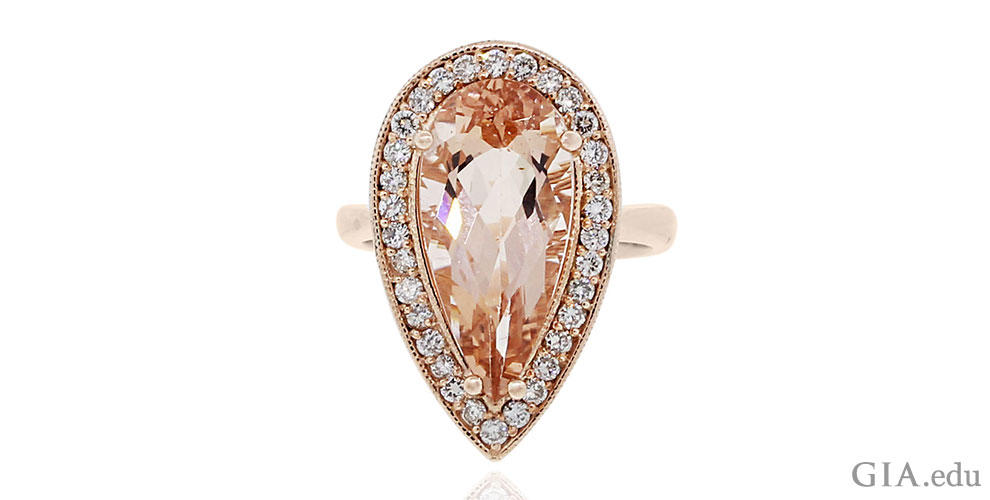Morganite engagement rings are trending – and for good reason. Morganite is a beautiful, durable and a comparatively affordable pink gem. It has also benefited from a lot of buzz. Here’s what you need to know about morganite engagement rings.
In this blog, we’ll cover:
Why is morganite so popular?
What type of gem is morganite?
Where does morganite come from?
Morganite qualities to look for
Adding diamonds to a morganite engagement ring
Setting ideas for morganite engagement rings
Caring for and cleaning a morganite engagement ring
Why is morganite so popular?

Morganite is a picture of romance in this ring featuring a 4.08 carat (ct) center stone encircled by diamonds that trail down the shank. The 18K rose gold setting accentuates the morganite’s color. Courtesy: 1stdibs.com
Interest in morganite engagement rings may have started in 2002, when Ben Affleck proposed to Jennifer Lopez with a 6.1 carat (ct) pink diamond. Pink picked up more momentum when Apple introduced its now iconic rose gold iPhone in 2013 and Pantone named “Marsala” — an earthy red hue that morganite compliments beautifully — the 2015 Color of the Year.
Fashion trends aside, pink has long been associated with love, romance, femininity and tenderness – so it’s not surprising that pink gems have an irresistible appeal. The color pink also flatters any skin tone.
The affordability of morganite engagement rings – especially compared to pink diamonds – puts the look within reach of brides-to-be. It is easy to see why morganite engagement rings, especially those with rose gold settings, have become so popular.
What type of gem is morganite?

All that seems to be missing from this 20.03 ct morganite ring is the bride who will wear it. Decorating the halo and band are 1.07 carats of diamonds. Courtesy: 1stdibs.com
Morganite is a delicate pastel pink to purplish pink (“rose”), yellowish pink (“peach”) or orangey pink (“salmon”) variety of beryl, a mineral species that also includes emerald, aquamarine and beryls in other colors. Its color is caused by traces of manganese. Strong hues in morganite are rare, and gems usually have to be fairly large to achieve the finest color.
Morganite is a 7.5 to 8 on the Mohs scale of hardness. This makes a morganite engagement ring suitable for everyday wear, although it is not as durable as harder gems like diamond or ruby and sapphire.
A fun piece of lore: Morganite was named to honor American financier and gem enthusiast J. P. Morgan (1837–1913). George Kunz, then Tiffany’s colored stone specialist and a noted gem scholar, proposed the name in 1910 after examining early samples of the beautiful pink beryl from Madagascar.

A 5.94 ct morganite is the star of this ring set in 14K rose gold with 0.70 carats of round brilliant cut diamonds. Courtesy: 1stdibs.com
Where does morganite come from?

It takes the skilled hands of a lapidary to turn a piece of morganite rough into a gem fit for a morganite engagement ring. Photo: Robert Weldon/GIA. Gift of Dave Wilber
Most of the morganite on the market today comes from Minas Gerais, Brazil. Minas Gerais is a gemological treasure chest: emerald, aquamarine, tourmaline, alexandrite, amethyst and topaz are some of the other gems found there.
Afghanistan, Pakistan, Mozambique, Namibia and the United States are also sources of morganite, but for the most part, production is minor and inconsistent. While it is no longer a major producer today, the original Madagascar deposit still sets the standard for the best material.
Morganite qualities to look for

It’s easy to fall in love with this charming morganite engagement ring. It features a 1.69 ct morganite and 0.08 carats of diamonds decorating the shank. Courtesy: 1stdibs.com
As you shop for a morganite engagement ring, keep in mind these tips for picking the perfect gem.
Color: The most prized morganite colors are strong pink, often the result of heat treatment. Untreated material, especially from Brazil, may be a salmon-like orangy pink. Morganite’s color is often pale, increasing in intensity with the size of the stone. Darker colors are usually more desired and thus cost more.
Morganite is almost always heat treated to improve its pink color. Heat drives off the yellow or orange tinge, leaving a purer and more attractive pink. The treatment is not detectable, and the resulting color is stable and won’t fade unless exposed to temperatures over 400°C.

Morganite is often found in large sizes and cut into a variety of shapes. This 10 ct oval morganite makes quite a fashion statement set horizontally in the trendy east-to-west style. The 18K rose gold setting includes four diamond accents in the prongs. Courtesy: 1stdibs.com
Clarity: Faceted morganite often does not have eye-visible inclusions, though they are more likely to be present in larger sizes. Stones with numerous eye-visible inclusions are usually carved or cut as cabochons. Liquid inclusions (liquid trapped in what were once voids in the gem) and fractures are two types of internal features that might be visible to the naked eye. Liquid inclusions tend to have irregular shapes. A fracture looks like a bright, shiny flat surface. It’s worth mentioning again that faceted morganite usually does not have eye-visible inclusions.
Cut: The shape of a morganite gem should have minimal effect on its beauty. Like a diamond, a morganite engagement ring can be attractive as a round brilliant, emerald cut, marquise or oval. Light-color material might be cut slightly deep to help intensify the color. Morganite is a popular material for unique fantasy cuts and carvings.
Carat weight: Although available (and affordable) in large stones, morganite is often cut in calibrated sizes to fit common jewelry mountings.

A solitaire is said to symbolize love, commitment and fidelity. This round morganite solitaire set in rose gold brings the power of pink to a traditional engagement ring style. Courtesy: 1stdibs.com
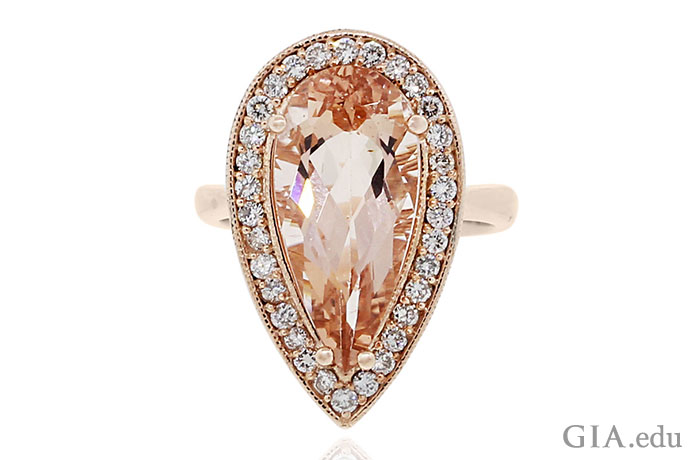
Pear shaped stones help give fingers a longer, slimmer look, and this 5.76 ct morganite ring is sure to flatter almost any hand. The delicate halo of diamonds totaling 0.58 carats adds to its feminine feel. Courtesy: TrueFacet.com
Adding diamonds to a morganite engagement ring
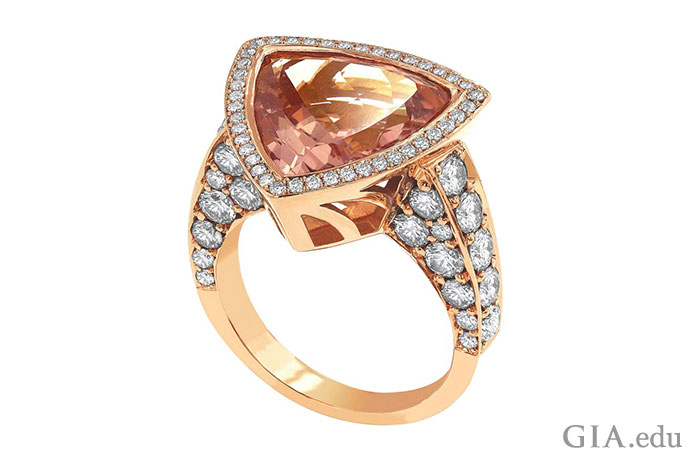
A romantic pairing: A 6.40 ct morganite with 2.45 carats of diamonds that form a halo and cascade down the shank as an enchanting counterpoint. Courtesy: 1stdibs.com
Now that you know what to look for when picking a beautiful morganite gemstone for your engagement ring, you might want to add a bit of drama to it. Morganite and diamonds form an elegant combination. The brilliance of the diamonds creates a dramatic contrast to the subtle blush of the morganite. Diamonds in a halo setting or flanking morganite as side stones are two can’t-fail choices. Here are a few things to keep in mind when selecting diamonds for your morganite engagement ring:
- The diamonds will probably reflect some of the pink of the morganite, so they may end up with a pinkish appearance.
- Diamonds that have a hint of yellow will probably complement the morganite, making for a softer look.
- Diamonds that are more colorless will contrast with the morganite, making for a bolder look.

Placing a diamond on either side of the central gem is another way to add diamonds to a morganite engagement ring. Here, an 8.68 ct morganite is framed by two pear shaped diamonds weighing a total of 0.40 carats. Courtesy: 1stdibs.com
Setting ideas for morganite engagement rings
Morganite works well in virtually all popular engagement ring setting styles. It’s stately enough to hold its own as a solitaire. It looks glorious with a halo (a ring of smaller diamonds placed around the center stone). And it is artfully framed and protected in a bezel setting (a jewelry setting style in which a thin metal strip is pushed or hammered around a gem to hold it in place).
Since morganite is a 7.5 to 8 on the Mohs scale of hardness, it is more vulnerable to chipping and breakage than a harder gem like a diamond. Because of this, you’ll want to put it in a setting that affords more protection. A bezel setting is an excellent choice, as the metal surrounding the morganite protects the gem from damage. Four- and six-prong settings are also common, but they offer less protection and aren’t an ideal choice for physically active individuals. All options considered, a bezel setting is the safest choice.
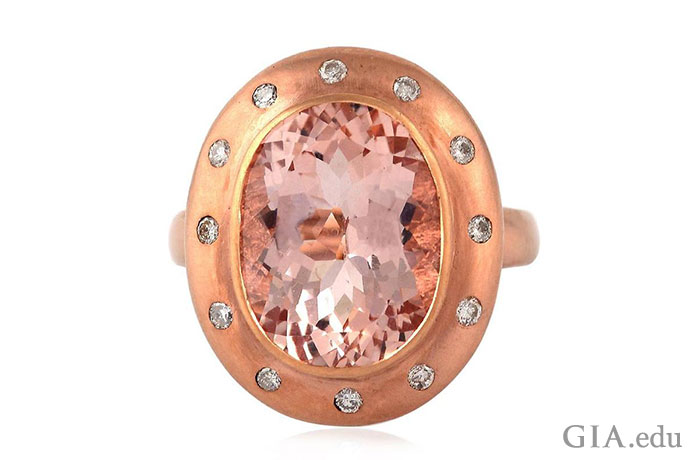
An antique frame cradling a magical mirror is a poetic description for this 6.19 ct morganite surrounded by 18K rose gold and 0.22 carats of diamonds. The rose gold setting not only protects the gemstone, but is also reflected in it, adding even more depth to the morganite’s pink hue. Courtesy: 1stdibs.com
If you’re looking for an engagement ring setting to complement morganite, consider the metal color and the overall look you’re trying to achieve. For a soft color palette, a rose gold band and prongs will enhance the gem’s pink hues, while yellow gold will bring out any yellow in the stone. Or you can opt to go bolder, by using white metal prongs or band (or both) to contrast with the morganite.

Consider the metal when choosing a setting for your morganite ring. You can use yellow gold to your advantage to bring out the yellow hues in some morganite, as in this morganite and diamond ring. Courtesy: Denise James
Caring for and cleaning a morganite engagement ring
Warm, soapy water is always a safe cleaning method for a morganite engagement ring. Cleaning by ultrasonic and steam cleaners is also usually safe, unless the stone has liquid inclusions or fractures. Rarely, morganite is fracture filled – a glass-like substance is used to fill a fracture to make it less visible and to improve the stone’s apparent clarity. These stones should only be cleaned with warm, soapy water.
A morganite engagement ring can be damaged by some acids, including those found in certain cleaning products. Morganite is safe to wear during most everyday activities. However, like all other gemstones, morganite can be damaged, so we recommend that you remove your ring before gardening, cleaning, playing sports or participating in other strenuous activities.
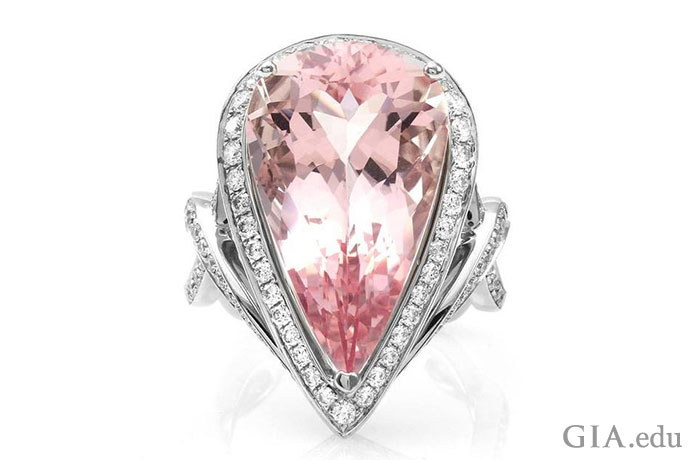
This 12.18 ct pear shaped morganite is framed by a halo of 1.06 carats of pavé diamonds. The white metal setting creates a strong contrast with the gem’s pink hue, making the morganite the star of the show. Courtesy: 1stdibs.com
Morganite in an engagement ring is sweet, romantic and trendy. It is also a charming choice – an eye-pleasing look that evokes the splendor of love.

Ready for romance? Loretta Castoro’s “Love Doves” ring has a 2 ct round morganite accented with diamonds in the shank. Courtesy: Loretta Castoro Signature Collection
Now that you’re well into your search for a center stone, learn how to select flattering engagement ring styles.
Custom Field: Array
